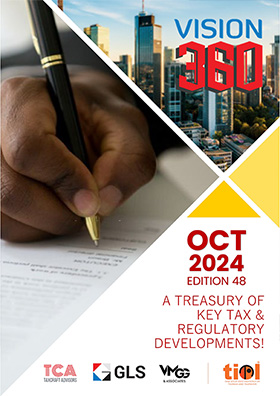Cus - When petitioner has accepted terms of settlement, they would be estopped from challenginge order of CCESC: High Court
By TIOL News Service
CHENNAI, OCT 15, 2016: THE petitioner has challenged the order dated 19.11.2004 passed by the Settlement Commission.
The allegation in the show causes was that an indenting agent (co-applicant before CCESC) for various textile materials from abroad collected AEPC certificate and other import documents for the import of polyester lining fabrics from the various petitioners/importers at Tiruppur and cleared the imported goods by availing concessional rate of duty under Customs Notification No.21 of 2002, dated 01.03.2002, took delivery on behalf of the importers and diverted the imported material to the local market.
Inasmuch as the goods imported, availing concessional rate of duty were not used in the manufacture of textile garments but diverted to domestic market in contravention of the said notification 21/2002-Cus and, therefore, the duty foregone amount along with interest is recoverable from the importer etc..
In respect of these SCNs the petitioners along with the indenting agent as co-applicant filed separate applications before the Settlement Commission and the same were admitted.
The petitioners admitted the violation but contended that the differential duty liability had been arrived at by taking into account the basic customs duty as applicable plus CVD at 16% plus Special Additional Duty (SAD) at 4%. It is their contention that SAD will not apply to the goods chargeable to additional duties levied under Section 3(1) of the Additional Duties of Excise (Goods of Special Importance) Act, 1957.
Reliance was placed on Central Excise Notification No.14 of 2002 stating that the subject goods are chargeable to excise duties at the consolidated rates at 16% and as per the first proviso below para 1 of the notification, the said 16% is to be apportioned equally between basic duty and Additional Duty of Excise (ADE).
The Revenue contended that the CVD at 16% proposed in the show cause notice is on the basis of serial No.410 of the table below Customs Notification No.21 of 2002 and, therefore, Special Additional Duty on the subject goods is leviable.
The Settlement Commission held that the imported goods ought to have been charged Additional Duty of Excise also, which the subject show cause notice has omitted to take into account and in view of the leviability of Additional Duty of Excise, the subject goods are not chargeable with SAD in the light of Section 3A(5) of the Customs Tariff Act, as claimed by the petitioners.
Therefore, the Settlement Commission directed the Revenue to work out the amount of duty leviable in the form of Customs Duty plus CVD at 16%, ADE at 8% and Cess at 0.05% on the impugned goods. Accordingly, the duty payable by each of the petitioners, taking into account the Basic Duty of Customs, CVD at 16%, ADE at 8% and Cess at 0.05% was furnished and the case was settled accordingly.
In paragraph 7 of the impugned order, the Commission recorded that the counsel for the petitioner and the Revenue accepted that ADE was leviable at 8%.
Nonetheless, the petitioners have challenged the said order.
It is inter alia submitted that the Settlement Commission had gone beyond the notification and imposed additional duty of 8%, which is neither provided by the Notification or under the statute.
The counsel appearing for the Revenue submitted that having conceded before the Settlement Commission that ADE at 8% is leviable, apart from, Cess, they could not have filed these Writ Petitions. Reliance is also placed on the decision of the Supreme Court in the case of State of Kerala vs. Attesee 1989 (72) STC 1 in support of the order.
The High Court observed -
"When the petitioner had accepted to the said fact and allowed the case to be settled on those terms, they would be estopped from contending that the concession so made will not be a bar to challenge the order of the Settlement Commission. Therefore, the Writ Petitions are liable to be dismissed on this ground."
Having observed thus, the High Court also proceeded to decide the matter on merits.
The High Court adverted to sub-section (5) of Section 3 of the Customs Tariff Act and after extracting the same relied on the apex Court decision (supra) further observed -
+ The above provision has been made with an object of counter balancing, the sales tax value of the article, when the same is removed to the domestic area. Therefore, when the Central Government is satisfied that in public interest to levy on any imported article, such additional duty as would counter balance the sales tax, value added tax, local tax, or any other charges on a like article on its sale, purchase or transportation in India, it may by notification in the official gazette direct that such imported article shall in addition be liable to an additional duty at a rate not exceeding 4% of the value of the imported article as specified in that Notification. The object of the above provision is to ensure that there is no loss of revenue to the States and appears to be with an object of being compensatory in nature for the States.
+ The additional duty leviable and the power to levy the Additional Duty of Excise is traceable to sub-section (5) of Section 3 of the Customs Tariff Act, 1975 which gives power to the Government to levy such additional duty as would counter balance the sales tax on a like article on its sale in India.
+ Admittedly, the goods which were imported by the petitioner were meant to be used for manufacture and the petitioners availed the benefit of the exemption notification. This condition having been violated and the goods having been cleared to the domestic area and the petitioner having accepted their mistake, the additional duty of excise is leviable in terms of sub-section (5) of Section 3 of the Customs Tariff Act. The exemption which is sought to be granted by the Budget Notification pertains to the duty leviable under sub-section (1) of Section 3 of the Customs Tariff Act and there is no reference to the additional duty of excise leviable in terms of sub-section (5).
+ Apart from the fact that the petitioner has already accepted before the Settlement Commission regarding the leviability of the additional duty of excise at 8%, it was definitely not entitled to go back on such submission and in the light of the above discussions, even on merits, the petitioner has not made out any case for interfering with the order passed by the Settlement Commission.
The Writ Petitions were dismissed.
In passing: Section 3A(5) of the Customs Tariff Act, 1975 read -
(5) Nothing contained in this section shall apply to any article, which is chargeable to additional duties levied under subsection (1) of section 3 of the Additional Duties of Excise (Goods of Special Importance) Act, 1957 (58 of 1957).
This section 3A [Special Additional Duty] was omitted by section 73 of the Finance Act, 2005 w.e.f 13.05.2005.
(See 2016-TIOL-2471-HC-MAD-CUS)















